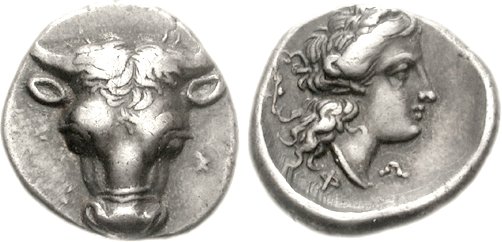S 1922 - Phocis (various mints) (Phocian League), silver, triobols (356-346 BCE)
From SILVER
356 BCE - 346 BCE Silver 2,273 kg
Description
| ObverseInscription or printing placed on the obverse.: | Facing bucranium |
| ReverseInscription or printing placed on the reverse.: | Φ - Ω (Greek).Laureate head of Apollo Delphios right, laurel branch to left |
Mint and issuing power
| MintIdentifies the place of manufacture or issue of a numismatic object.: | Phocis (various mints) | Ancient regionAncient region.: | Phocis | Modern countryModern country: Greece | AuthorityIdentifies the issuing power. The authority can be "pretended" when the name or the portrait of X is on the coin but he/she was not the issuing power. It can also be "uncertain" when there is no mention of X on the coin but he/she was the issuing power according to the historical sources: | Phocian League |
Chronology
| FromIdentifies the initial date in a range assigned in a numismatic context. | 356 BCE | toIdentifies the final date in a range assigned in a numismatic context.. | 346 BCE | PeriodTime period of the numismatic object.: Classical 480-323 BC |
Physical description
| MetalThe physical material (usually metal) from which an object is made.: | Silver |
Median weightMedian of the weights of numismatic objects (in grams). in grams | 2.70 | DenominationTerm indicating the value of a numismatic object. Examples: tetradrachm, chalkous, denarius.: | triobol |
StandardStandard.: |
Image

S1922 Phocis triobols Gr. V.jpg [1]
References
| Die study referencePublication of the study: | Williams 19721Williams 1972, p. 118-131, n° 302-328, 332-355, 368-405, 411-413 (Period V) | ||
| Coin series referenceReference to coin series study: | Sear I2Sear I, n° 2353, HGC 43HGC 4, n° 1050 | ||
| Coin series web referenceCoin series web references: | |||
Obverse dies distribution
| FrequencyFrequency of specimen in distribution. ᵖ | Number of obversesNumber of obverse dies. ᵖ (o) | % (o) | Number of coinsNumber of coins. (n) | % (n) | Die nameName(s) of the die(s). |
| 1 | 10 | 27.03 | 10 | 6.1 | 225, 230, 232, 234, 238, 240, 244, 246, 247, 248 |
| 2 | 8 | 21.62 | 16 | 9.76 | 227, 229, 236, 239, 241, 242, 243, 267 |
| 3 | 5 | 13.51 | 15 | 9.15 | 224, 228, 233, 235, 249 |
| 4 | 2 | 5.41 | 8 | 4.88 | 237, 245 |
| 6 | 3 | 8.11 | 18 | 10.98 | 221, 222, 231 |
| 7 | 2 | 5.41 | 14 | 8.54 | 220, 223 |
| 8 | 1 | 2.7 | 8 | 4.88 | 226 |
| 9 | 1 | 2.7 | 9 | 5.49 | 264 |
| 12 | 3 | 8.11 | 36 | 21.95 | 261, 265, 266 |
| 14 | 1 | 2.7 | 14 | 8.54 | 262 |
| 16 | 1 | 2.7 | 16 | 9.76 | 263 |
| Total | 37 of 37 | 100 | 164 of 164 | 100.03 |
Reverse dies distribution
no distribution is available
Quantification
| Number of obversesNumber of obverse dies. ᵖ (o) | 37 | Number of singletons (o1)The number of singleton coins. ᵖ | 18 |
| Number of reverse diesNumber of reverse dies. (r) | Number of coinsNumber of coins. (n) | 164 | |
| Coins per obverse dieNumber of coins per obverse die. (n/o) | 4.43 | Coins per reverse dieNumber of coins per reverse die. (n/r) | |
| Reverse per obverse ratioRatio of obverse dies divided by reverse dies. (r/o) | Percentage of singletons (o1)number of coins (n) divided by the number of singletons (o1) ᵖ | 48.65 % | |
| Original number of dies (O) (Carter 1983 formula)The estimation of the number of coins according to Carter 1983 ᵖ | 42.1 | Coins struck if 20,000 as average productivity per dieCoins made if the average productivity for obverses (according to Carter) is 20,000. ᵖ | 842,000 |
| Original number of dies (O) (Esty 2011 formula)The estimation of the number of coins according to the singleton formula in Esty 2011 ᵖ (O) | 47.78 | Survival rate if 20,000 as average productivity per dieSurvival rate if average productivity is 20,000. ᵖ | 0.00019 |
| Coverage (o = % of O) (Esty 1984 formula)Esty 1984 - coverage (% of O) ᵖ (o = % of O) | 89.02% | Die productivity if survival rate 1/2,000Average productivity if survival rate is 1/2,000. ᵖ | 7,790.97 |
| Weight of silver (in kg) if 20,000 coins per die (O = Carter formula)Carter 1983 * Median weight * 20000 (*10 if gold or electrum) ᵖ | 2,273 kg <br /> 2,273 kg | Die productivity if survival rate 1/5,000Average productivity if survival rate is 1/5,000. ᵖ | 19,477.43 |
Remarks
Most likely more than 2 workstations